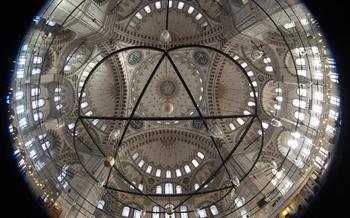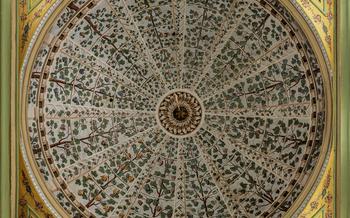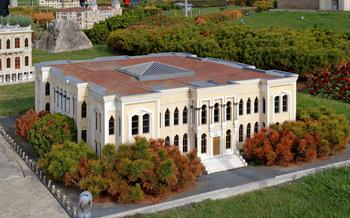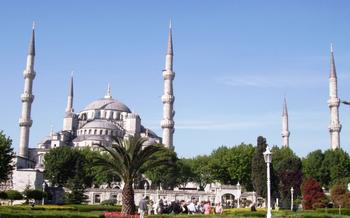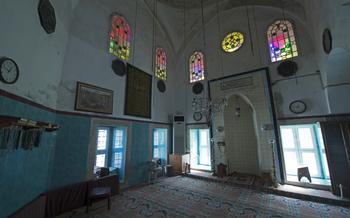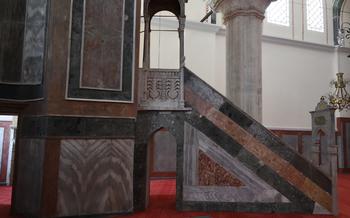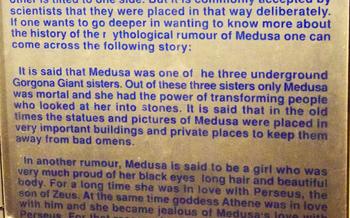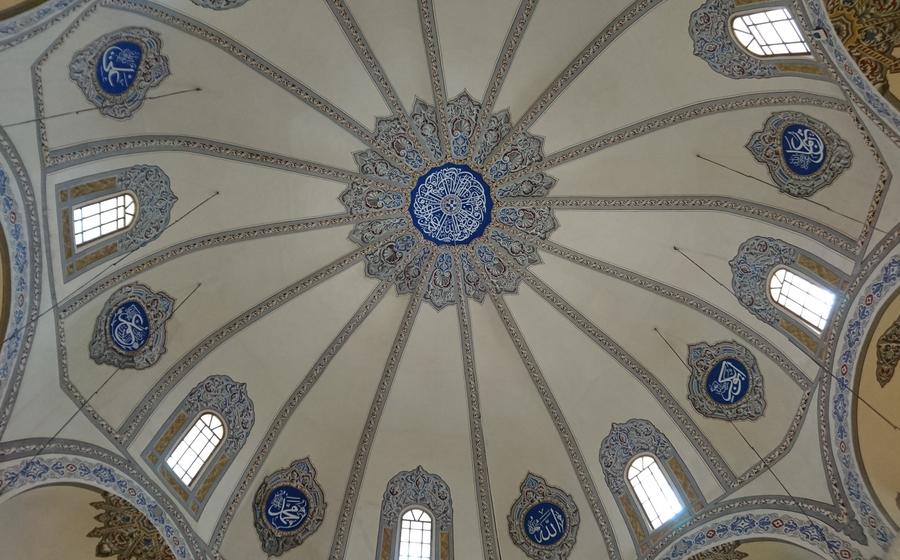
Kucuk Ayasofya (Little Hagia Sophia)
- Historical Significance:
- Architectural Marvel: A Masterpiece of Byzantine Architecture
- Mosaics and Frescoes: A Testament to Byzantine Art
- Transformation into a Mosque
- Current Status and Restoration Efforts
- Location and Accessibility
- Hours of Operation and Admission Fees
- Exploring the Neighborhood
- Photography and Videography
- Dress Code and Etiquette
- Accessibility for Visitors with Disabilities
- Local Guides and Tours
- Best Time to Visit
- Nearby Attractions
- Insider Tip: Unveiling the Hidden Beauty
Historical Significance:
The Kucuk Ayasofya, also known as the Little Hagia Sophia or the Church of the Holy Apostles, holds immense historical and cultural significance in Istanbul. Built in the 6th century during the reign of Emperor Justinian I, it was originally a Byzantine church dedicated to the Holy Apostles Peter and Paul and served as a patriarchal basilica. Its construction was overseen by the same architects who designed the iconic Hagia Sophia, resulting in a striking resemblance between the two structures. However, unlike the Hagia Sophia, which was converted into a mosque after the Ottoman conquest of Constantinople, the Kucuk Ayasofya remained a Christian church throughout the Byzantine era. Its architectural grandeur and religious importance made it a symbol of Byzantine power and influence in the city.
Architectural Marvel: A Masterpiece of Byzantine Architecture
The Kucuk Ayasofya, also known as the Church of the Holy Apostles, stands as a testament to the architectural brilliance of the Byzantine Empire. Its stunning dome, intricate mosaics, and beautiful frescoes are a feast for the eyes, showcasing the artistic prowess and technical skills of Byzantine builders and artisans. The dome, a defining feature of the church, is a marvel of engineering, demonstrating the mastery of Byzantine architects in constructing large-scale structures. The intricate mosaics that adorn the interior depict biblical scenes, historical figures, and decorative patterns, offering a glimpse into the rich iconography and religious beliefs of the Byzantine era. The frescoes, painted on the walls and ceiling, showcase the vibrant colors and expressive style characteristic of Byzantine art. The harmonious blend of these architectural elements creates a breathtaking masterpiece that transports visitors back in time to the grandeur of the Byzantine Empire.
Mosaics and Frescoes: A Testament to Byzantine Art
The interior of the Kucuk Ayasofya is adorned with exquisite mosaics and frescoes, a testament to the vibrant and sophisticated artistic traditions of the Byzantine Empire. These artworks, created by skilled artisans over centuries, depict a rich tapestry of biblical scenes, historical figures, and decorative patterns, offering a glimpse into the religious and cultural beliefs of the time.
One of the most striking mosaics is located in the apse, the semi-circular recess behind the altar. It portrays the Virgin Mary enthroned with the infant Jesus in her arms, flanked by angels and saints. The mosaic is a masterpiece of Byzantine iconography, capturing the essence of the Virgin's role as the intercessor between God and humanity.
Other notable mosaics adorn the walls and vaults of the church, depicting scenes from the life of Christ, including his birth, baptism, crucifixion, and resurrection. These images served as a visual narrative for the faithful, reinforcing the teachings of the Christian faith. The mosaics also showcase the technical prowess of Byzantine artists, with their intricate details, vibrant colors, and lifelike expressions.
In addition to the mosaics, the Kucuk Ayasofya is home to a collection of beautiful frescoes, painted directly onto the plaster walls. These frescoes depict a variety of subjects, including saints, martyrs, and scenes from the Old and New Testaments. The frescoes add a sense of warmth and intimacy to the interior, creating a sacred space that invites contemplation and devotion.
The mosaics and frescoes of the Kucuk Ayasofya are not only works of art but also valuable historical documents, providing insights into the beliefs, practices, and artistic traditions of the Byzantine Empire. They are a testament to the enduring legacy of this influential civilization and continue to inspire and captivate visitors to this day.
Transformation into a Mosque
During the Ottoman conquest of Constantinople in 1453, the Kucuk Ayasofya underwent a significant transformation. As the Ottomans established their rule over the city, they converted many Byzantine churches into mosques, and the Kucuk Ayasofya was no exception. The building's original function as a Christian church was replaced by its new role as a place of Islamic worship.
To accommodate this change, several modifications were made to the structure. A minaret, a slender tower used for the call to prayer, was added to the exterior, becoming a prominent feature of the cityscape. Inside, a mihrab, a niche indicating the direction of Mecca, was installed in the wall facing southeast, guiding worshippers during their prayers.
The conversion of the Kucuk Ayasofya from a church to a mosque reflected the changing religious and cultural landscape of Istanbul. The city, once the heart of the Byzantine Empire, was now the capital of the Ottoman Empire, and Islam became the dominant religion. This transformation left an indelible mark on the city's architecture and cultural heritage, as many Byzantine churches were converted into mosques, blending Christian and Islamic elements to create a unique architectural tapestry.
Current Status and Restoration Efforts
Today, the Kucuk Ayasofya stands as a testament to the city's rich history, serving as a museum that welcomes visitors from around the world. Extensive restoration efforts have been undertaken to preserve and showcase its historical and architectural significance. These efforts involve meticulous cleaning and conservation of the mosaics, frescoes, and structural elements to ensure the site's longevity. The restoration works not only aim to maintain the integrity of the building but also to enhance the visitor experience, allowing them to appreciate the intricate details and beauty that define this architectural marvel.
The Turkish government, in collaboration with international experts, has played a crucial role in overseeing these restoration projects. By investing in the preservation of the Kucuk Ayasofya, Turkey demonstrates its commitment to safeguarding its cultural heritage and ensuring that future generations can continue to marvel at this Byzantine masterpiece. These ongoing efforts reflect the country's deep appreciation for its historical treasures and its dedication to preserving them for the benefit of both locals and visitors alike.
Location and Accessibility
The Kucuk Ayasofya is conveniently located in the historic district of Istanbul, known as Fatih. To reach the site, visitors can take advantage of the city's well-connected public transportation system. The closest tram stop is Sultanahmet, which is just a short walk away. Alternatively, visitors can take a scenic ferry ride across the Golden Horn and disembark at the Eminönü pier, followed by a leisurely stroll to the Kucuk Ayasofya.
Once you arrive in the vicinity of the Kucuk Ayasofya, you'll find yourself surrounded by a vibrant neighborhood steeped in history and culture. The site is nestled amidst narrow cobblestone streets, charming cafes, and traditional Turkish shops, offering a delightful ambiance for exploration. Moreover, the Kucuk Ayasofya's proximity to other popular tourist attractions, such as the Hagia Sophia, the Blue Mosque, and the Topkapi Palace, makes it an ideal starting point for a comprehensive tour of Istanbul's historical treasures.
Hours of Operation and Admission Fees
The Kucuk Ayasofya is open to visitors every day of the week, except for Wednesdays. The opening hours are from 9:00 AM to 5:00 PM, with the last entry permitted at 4:30 PM. However, it's worth noting that the site may occasionally close for special events or maintenance purposes, so it's advisable to check the official website or contact the authorities beforehand to confirm the exact hours of operation.
Admission to the Kucuk Ayasofya is free of charge, making it an accessible and budget-friendly attraction for visitors. This allows travelers to explore the rich history and stunning architecture of the site without any financial constraints. It's important to remember that the free admission policy encourages visitors to respect and preserve the historical significance of the Kucuk Ayasofya.
Exploring the Neighborhood
The Kucuk Ayasofya is nestled in the vibrant neighborhood of Sultanahmet, the historical heart of Istanbul. This area is a treasure trove of cultural and historical landmarks, offering visitors a glimpse into the city's rich past. After exploring the Kucuk Ayasofya, take some time to wander through the charming streets of Sultanahmet and discover its hidden gems.
Stroll along Divan Yolu Street, the main artery of the neighborhood, and admire the beautiful Ottoman-era buildings that line the street. Stop by one of the many cafes or restaurants for a refreshing drink or a delicious Turkish meal. If you're in the mood for some shopping, visit the Arasta Bazaar, a traditional covered market where you can find a variety of souvenirs and handicrafts.
Don't miss the opportunity to visit other historical landmarks in the area, such as the iconic Hagia Sophia, the Blue Mosque, and the Topkapi Palace. These magnificent structures are a testament to Istanbul's rich history and architectural prowess. Take a guided tour to learn more about their fascinating stories and admire their stunning interiors.
Sultanahmet is a neighborhood that seamlessly blends history with modernity. Whether you're interested in exploring ancient ruins, shopping for souvenirs, or simply soaking up the vibrant atmosphere, this neighborhood has something to offer every visitor.
Photography and Videography
The Kucuk Ayasofya offers ample opportunities for capturing stunning photographs and videos. Photography is generally permitted inside the site, but flash photography and tripods are strictly prohibited. This is to preserve the delicate mosaics and frescoes from damage caused by excessive light and vibration.
The best spots for photography are within the main hall, where you can capture the grandeur of the dome and the intricate details of the mosaics. For a unique perspective, head to the upper galleries, which offer panoramic views of the interior and the surrounding neighborhood.
Videography is also permitted, but it is essential to be respectful of other visitors and avoid blocking their views. Drones are strictly prohibited within the site and its surroundings.
To ensure the best results, visit the Kucuk Ayasofya during the morning or late afternoon when the natural light is most favorable. Avoid visiting during peak tourist hours to minimize crowds and distractions in your photos and videos.
Dress Code and Etiquette
When visiting the Kucuk Ayasofya, it is essential to be respectful of the religious and cultural significance of the site. Visitors should dress modestly and avoid wearing revealing or provocative clothing. Shorts, tank tops, and swimwear are not appropriate attire for this sacred space. It is also important to be mindful of noise levels and to avoid disturbing other visitors or worshippers. Photography and videography are permitted inside the mosque, but visitors should be discreet and avoid using flash or tripods. Taking photos or videos of people without their consent is not allowed. Visitors should also refrain from touching or leaning against the walls or artwork, as these are delicate and irreplaceable treasures. By following these guidelines, visitors can help preserve the sanctity and beauty of the Kucuk Ayasofya for future generations to appreciate.
Accessibility for Visitors with Disabilities
The Kucuk Ayasofya is committed to providing an accessible and enjoyable experience for all visitors, including those with disabilities. Several accessibility features are in place to facilitate their visit.
Wheelchair users and visitors with limited mobility can easily access the site through designated ramps and elevators. Once inside, the ground floor, including the main entrance, prayer hall, and exhibition area, is wheelchair-accessible, allowing visitors to explore the site's highlights without barriers.
The museum also provides assistive devices such as wheelchairs and audio guides upon request. Staff members are trained to assist visitors with disabilities, ensuring they have a comfortable and informative experience. Furthermore, accessible restrooms are available for the convenience of visitors with special needs.
Visitors with visual impairments can benefit from the tactile models and audio descriptions of the site's architectural features. These aids help them understand the layout and appreciate the intricate details of the Kucuk Ayasofya's design.
By incorporating these accessibility features, the Kucuk Ayasofya ensures that all visitors, regardless of their abilities, can fully experience and appreciate its historical and cultural significance.
Local Guides and Tours
Exploring the Kucuk Ayasofya with a knowledgeable local guide or joining a guided tour can significantly enhance your experience. These experts can provide historical context, insights into the architecture and artwork, and anecdotes that bring the site to life. They can also help you navigate the crowds, ensuring you don't miss any important details.
Various tour options are available, from private guided tours tailored to your specific interests to group tours that offer a more social experience. Guided tours often include skip-the-line access, allowing you to bypass the queues and make the most of your time at the Kucuk Ayasofya.
If you prefer a self-guided tour, consider renting an audio guide or downloading a mobile app that provides information about the site. These resources can be particularly helpful if you're interested in learning more about the history and significance of the Kucuk Ayasofya at your own pace.
Best Time to Visit
To fully appreciate the grandeur of the Kucuk Ayasofya and avoid the sweltering summer heat, the best time to visit is during the shoulder seasons (spring and fall), when the weather is mild and pleasant. The months of April, May, September, and October offer ideal conditions for exploring the site without the overwhelming crowds of the summer months.
Early mornings or late afternoons are also recommended to beat the midday heat and capture the best light for photography. Additionally, visiting on weekdays rather than weekends can help you avoid the influx of tourists and enjoy a more tranquil experience.
During the holy month of Ramadan, the Kucuk Ayasofya may have adjusted opening hours or special events, so it's advisable to check in advance to plan your visit accordingly.
Nearby Attractions
The Kucuk Ayasofya is surrounded by a wealth of historical and cultural attractions that visitors can easily explore on foot. A short walk away lies the Suleymaniye Mosque, a masterpiece of Ottoman architecture and one of the largest mosques in Istanbul. Its serene courtyard, intricate tilework, and stunning views over the city make it a must-visit for any traveler.
Another nearby attraction is the Arasta Bazaar, a charming covered market located just behind the Suleymaniye Mosque. This vibrant bazaar offers a unique shopping experience, where visitors can browse through a variety of traditional Turkish handicrafts, souvenirs, and antiques. From colorful carpets and intricate jewelry to handmade ceramics and delicious Turkish delights, the Arasta Bazaar is a great place to find unique gifts and treasures.
For those interested in history, the Museum of Turkish and Islamic Arts is a must-see. Housed in the former palace of Ibrahim Pasha, this museum showcases a vast collection of Islamic art and artifacts from across the centuries. Visitors can admire exquisite carpets, intricate calligraphy, and stunning ceramics, gaining a deeper understanding of the rich cultural heritage of Turkey and the Islamic world.
By combining a visit to the Kucuk Ayasofya with these nearby attractions, visitors can create a comprehensive and enriching cultural experience that immerses them in the history, art, and traditions of Istanbul.
Insider Tip: Unveiling the Hidden Beauty
For a unique perspective on the Kucuk Ayasofya, venture to the upper gallery. This hidden gem offers a breathtaking view of the intricate mosaics and frescoes adorning the interior of the dome. As you gaze upon these stunning artworks from above, you'll gain a newfound appreciation for the craftsmanship and artistry that went into their creation. Remember to bring your camera to capture this special moment, as the upper gallery provides an unparalleled opportunity to document the beauty of the Kucuk Ayasofya from a different angle.
